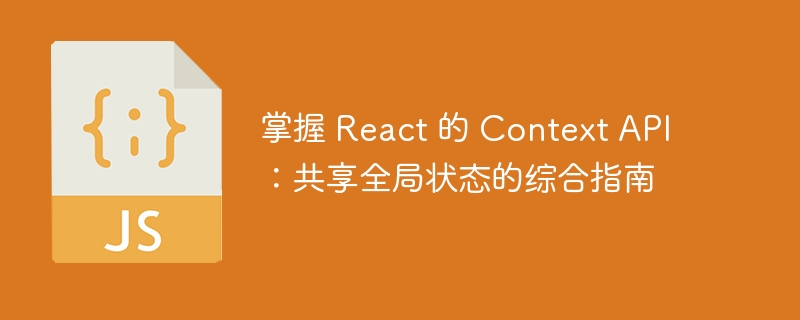
React Context API:跨组件高效共享数据
React 的 Context API 提供了一种在组件间共享数据的高效机制,无需层层传递 props,尤其适用于管理全局状态,例如主题、认证信息或用户偏好设置。
1. Context API 简介
Context API 创建了一种全局状态,无论组件嵌套深度如何,任何组件都能访问。这避免了繁琐的 prop-drilling,使代码更简洁易维护。
2. Context API 工作原理
Context API 主要包含三个部分:
React.createContext():创建一个包含共享值的 Context 对象。Context.Provider:向组件树提供 Context 值。Context.Consumer 或 useContext 钩子:用于访问 Context 值。3. 创建和使用 Context
首先,用 React.createContext() 创建 Context。此函数返回一个对象,包含 Provider 和 Consumer。
示例:创建和使用 Context
<code class="javascript">import React, { createContext, useState } from 'react';
// 创建 Context
const ThemeContext = createContext();
const ThemeProvider = ({ children }) => {
const [theme, setTheme] = useState('light');
const toggleTheme = () => {
setTheme(theme === 'light' ? 'dark' : 'light');
};
return (
<ThemeContext.Provider value={{ theme, toggleTheme }}>
{children}
</ThemeContext.Provider>
);
};
const ThemedComponent = () => {
return (
<ThemeContext.Consumer>
{({ theme, toggleTheme }) => (
<div style={{ backgroundColor: theme === 'light' ? 'white' : 'black', color: theme === 'light' ? 'black' : 'white' }}>
<p>当前主题:{theme}</p>
<button onClick={toggleTheme}>切换主题</button>
</div>
)}
</ThemeContext.Consumer>
);
};
const App = () => {
return (
<ThemeProvider>
<ThemedComponent />
</ThemeProvider>
);
};
export default App;</code>说明:
createContext() 创建 ThemeContext。ThemeProvider 组件管理主题状态,并通过 Provider 提供给子组件。ThemedComponent 使用 Context.Consumer 访问和使用 Context 值。4. 使用 useContext 钩子 (函数式组件)
React 16.8 及以后版本,函数式组件可以使用 useContext 钩子更方便地访问 Context 值。
示例:使用 useContext 钩子
<code class="javascript">import React, { createContext, useState, useContext } from 'react';
// 创建 Context
const ThemeContext = createContext();
// ... (ThemeProvider remains the same) ...
const ThemedComponent = () => {
const { theme, toggleTheme } = useContext(ThemeContext);
return (
<div style={{ backgroundColor: theme === 'light' ? 'white' : 'black', color: theme === 'light' ? 'black' : 'white' }}>
<p>当前主题:{theme}</p>
<button onClick={toggleTheme}>切换主题</button>
</div>
);
};
// ... (App remains the same) ...</code>说明:
useContext 直接访问 Context 提供的值,比 Context.Consumer 更简洁。
5. Context API 最佳实践
6. 示例:认证 Context
以下示例展示如何使用 Context API 管理应用的认证状态:
<code class="javascript">import React, { createContext, useState, useContext } from 'react';
const AuthContext = createContext();
const AuthProvider = ({ children }) => {
const [user, setUser] = useState(null);
const login = (userName) => setUser({ name: userName });
const logout = () => setUser(null);
return (
<AuthContext.Provider value={{ user, login, logout }}>
{children}
</AuthContext.Provider>
);
};
const Profile = () => {
const { user, logout } = useContext(AuthContext);
return user ? (
<div>
<p>欢迎,{user.name}!</p>
<button onClick={logout}>登出</button>
</div>
) : (
<p>请登录。</p>
);
};
const App = () => {
const { login } = useContext(AuthContext);
return (
<AuthProvider>
<button onClick={() => login('John Doe')}>登录</button>
<Profile />
</AuthProvider>
);
};
export default App;</code>7. 结论
Context API 是 React 中强大的状态管理工具,简化了状态管理,避免了 prop-drilling,方便管理全局数据,例如认证、主题或语言设置。 createContext()、Provider 和 useContext() 组合使用,能高效且易维护地传递数据。
以上就是掌握 React 的 Context API:共享全局状态的综合指南的详细内容,更多请关注php中文网其它相关文章!

每个人都需要一台速度更快、更稳定的 PC。随着时间的推移,垃圾文件、旧注册表数据和不必要的后台进程会占用资源并降低性能。幸运的是,许多工具可以让 Windows 保持平稳运行。

Copyright 2014-2025 https://www.php.cn/ All Rights Reserved | php.cn | 湘ICP备2023035733号